Business Resources
The purpose of this section is to teach how to identify and manage spotted lanternfly at your place of work and to prevent the spread of this pest to new locations. Spotted lanternfly is an incredible hitchhiker on commercial goods and materials at all life stages. Spotted lanternfly may impact but, not limited to the following industries.
- Agriculture
- Forest Products
- Green Industry Professionals
- Commercial Businesses
- Interstate & International Shipping Companies (Road, Rail and Air)
Quarantine Regulations
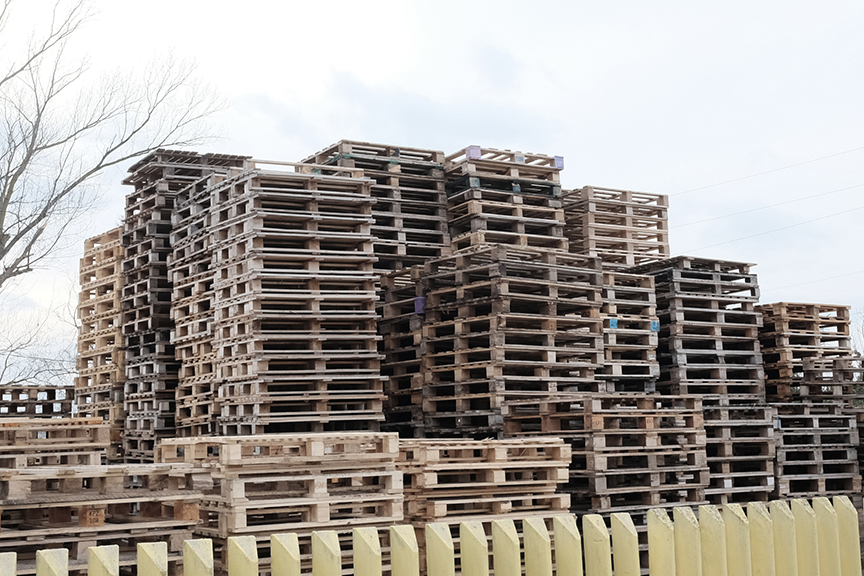 Photo of wooden pallets - a regulated article
Photo of wooden pallets - a regulated article
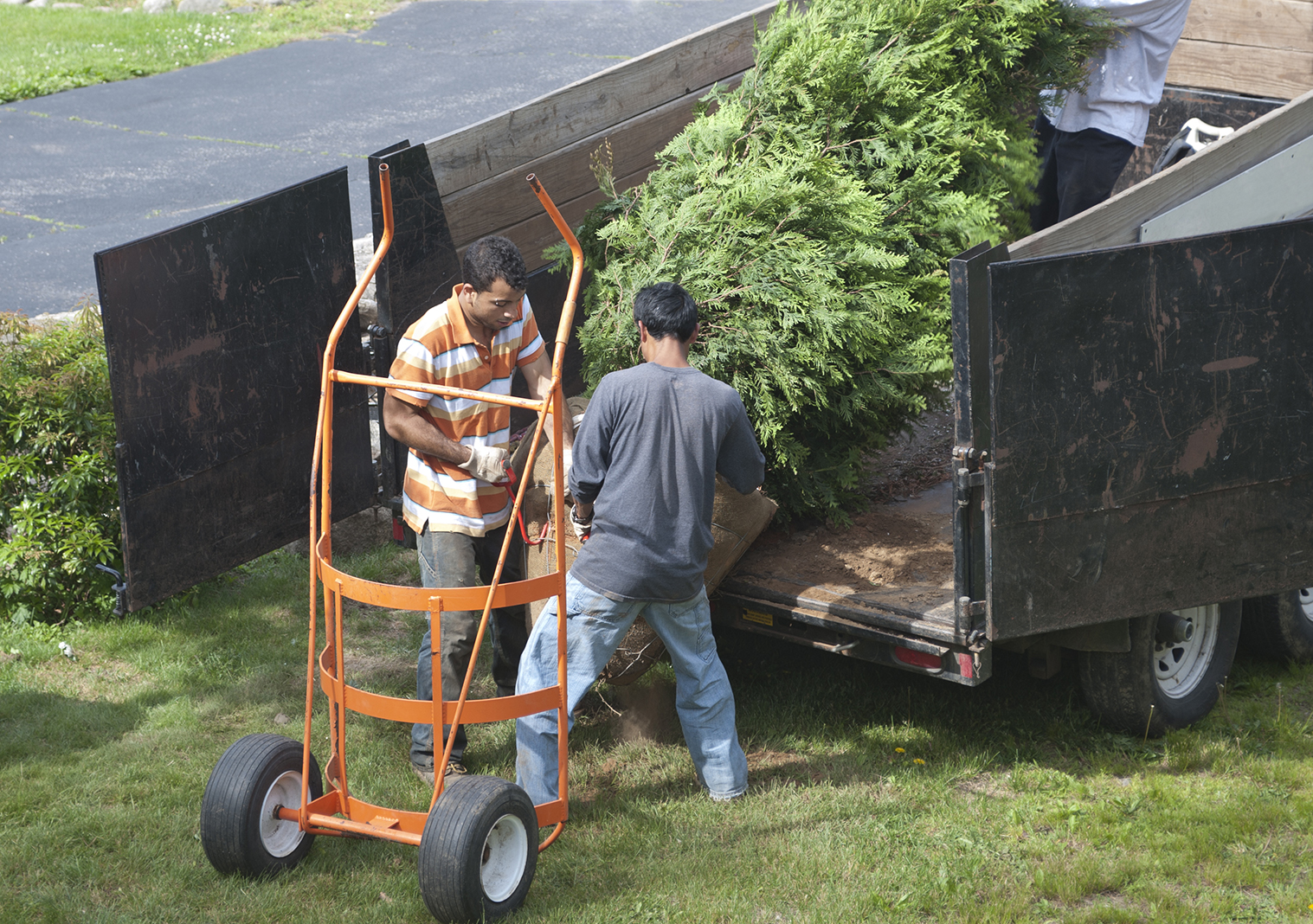 Landscaping , remodeling, and construction waste
Landscaping , remodeling, and construction waste
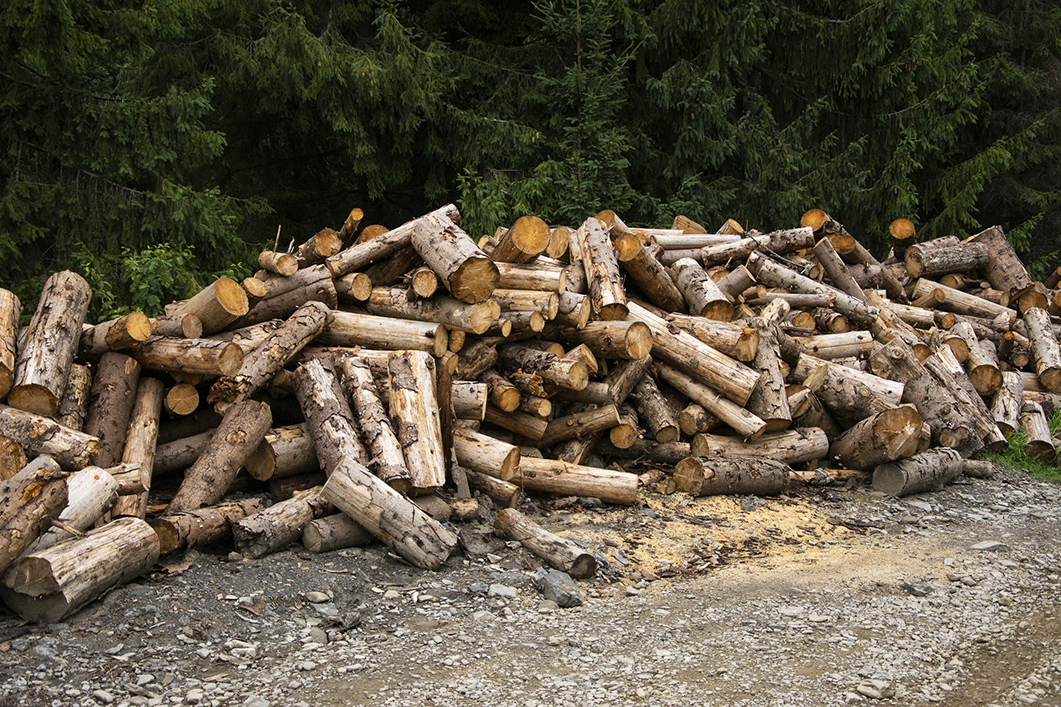 Firewood, logs, stumps
Firewood, logs, stumps
To stop the spread of spotted lanternfly (SLF), the New Jersey Department of Agriculture (NJDA) issued a quarantine for counties where SLF has been confirmed. This quarantine requires all businesses and organizations moving within or from the quarantine zone in the course of their work to obtain permits issued by NJDA.
The quarantine strictly prohibits the movement of any SLF living stage including egg masses, nymphs, and adults, and restricts the movement of articles that may harbor the insect. The following are examples of but not limited to restricted articles:
- Landscaping, remodeling or construction waste
- Logs, stumps, or any tree parts
- Firewood of any species
- Grapevines for decorative purposes or as nursery stock
- Nursery stock
- Packing materials such as pots, crates, pallets, etc.
- Outdoor household articles including recreational vehicles, tractors and mowers, grills and furniture and their covers, tarps, mobile homes, tile, stone, deck boards, mobile fire pits, any associated equipment and vehicles not stored indoors
New Jersey Spotted Lanternfly Quarantine For General Audience
NJ Spotted Lanternfly Quarantines Rules – see Subchapter 10 to Quarantines regulations
NJ Quarantine Map by County
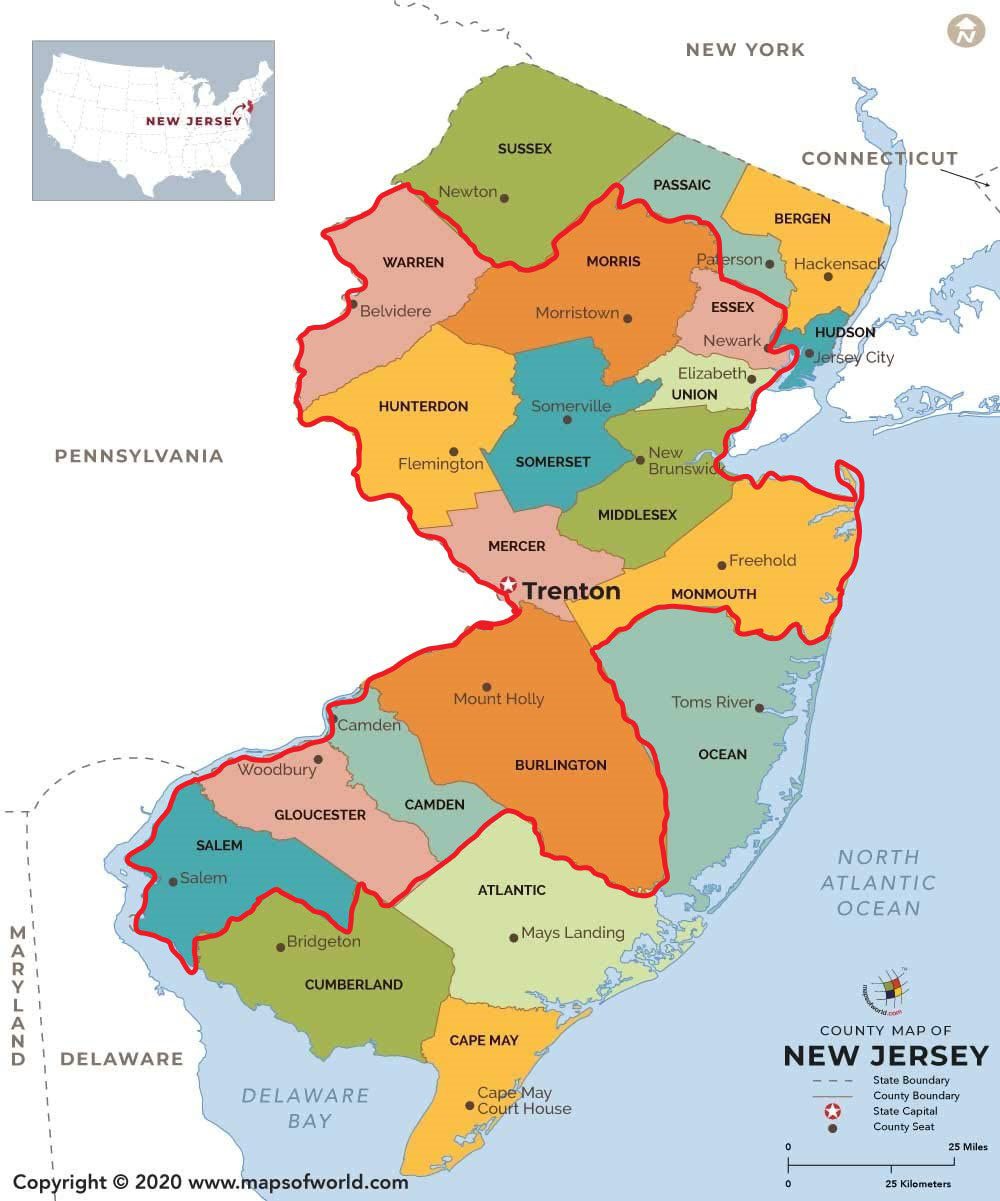 Mapf of NJ with counties that are quarantines highlightes. Refernce list in this section.
Mapf of NJ with counties that are quarantines highlightes. Refernce list in this section.
All New Jersey counties are now quarantined.
Permits and Training
In order to prevent the spread of spotted lanternfly to new areas and potentially new states New Jersey Department of Agriculture has enacted a quarantine program in counties where this insect pest has been confirmed. In accordance to the NJDA SLF regulations, companies and organizations conducting business in the quarantine zone must have a permit from NJDA to move vehicles, equipment and other goods within and out of the zone. In order to move products, both the business and transport company must have a spotted lanternfly permit. The permits are universally accepted from other states as singularly recognized permit program. Only one permit is required for each business, however, if there are multiple locations it may be best to get a permit for each location. Please place a copy of the permit with the items being transported along with the paperwork.
If you transport any products into or within the quarantine zone, you need to have a permit issued by the New Jersey Department of Agriculture. By taking a simple training and completing a quiz, you will demonstrate your knowledge of the biology of this invasive insect and learn about the measures to minimize the spread of the Spotted Lanternfly.
A permit provides evidence that you have completed training on how to follow the rules of the quarantine order, and you agree to do all you can to ensure that you are not transporting SLF. You will receive a tag for your vehicles to show that you have the SLF permit from the PDA.
Who should take the training within the business?
Penn State Extension and NJDA have developed a self-paced, “train the trainer" online course to train designated employees - usually an owner, manager, or supervisor - within a company on how to comply with the quarantine regulations. Once a designated employee passes the course, they will receive from NJDA the requested number of spotted lanternfly permits for company vehicles.
The designated employee must train fellow employees before granting them a permit.
How to obtain a permit from NJDA
If your business or organization meets the criteria for requiring a spotted lanternfly permit, the designated employee(s) need to complete the online course offered by Penn State Extension and NJDA. This free, self-paced course will provide the information and resources necessary for the designated employee to then train fellow employees about best operating procedures within the quarantine zone. The requested number of vehicle permits will be issued to the business once the designated employee passes the online course.
General Business and Green Industry Permits
Train the Trainer PowerPoint Slides
New Jersey Spotted Lanternfly Permit Participants
New Jersey Residence Checklist (English)
New Jersey Residence Checklist (Spanish)
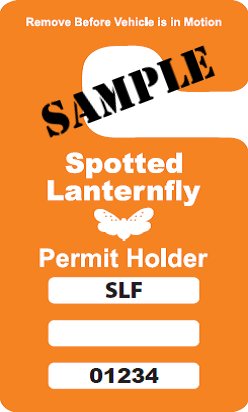
permit from NJDA FRONT
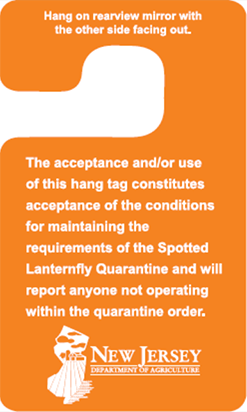
permit from NJDA BACK
Best Management Practices
Forest Product Industry (PDF)
Green Industry (PDF)
Tree Fruit Industry (PDF)
Wine and Vineyard Industry (PDF)
Trucking Industry (PDF)
Pesticide Recommendations
Management & Control Options

Monitoring
As mentioned above, SLF utilizes a large range of plant hosts. Home gardeners have reported SLF feeding on their backyard plants, including cucumbers, basil, rose, peony, Russian sage, and more. In most cases, SLF will only feed on these herbaceous plants for a short period of time (less than one week). In some cases, damage on these plants has also been reported. Whether or not damage occurs appears to be largely dependent on the density of the population and other plants in proximity. We highly recommend that you monitor for SLF on a regular basis to try to predict where SLF is likely to feed and move in a given area. If there are other highly desirable hosts nearby, we recommend you focus monitoring and potential treatment on those plants. Monitoring can be done through visual inspection.
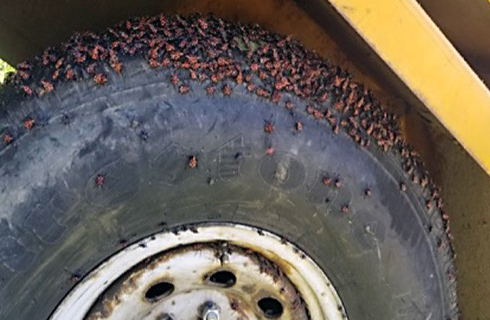
Monitoring for nymphs, egg masses, and adults: Numerous spotted lanternfly nymphs congregating on top of tire inside wheel well of truck. Photo: PA Department of Agriculture.
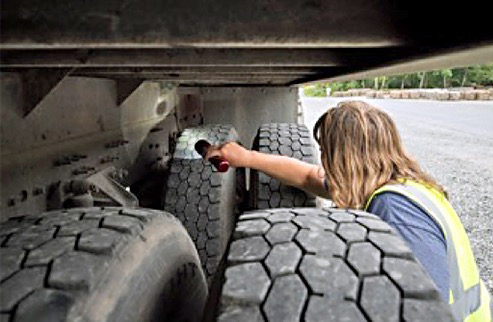
Monitoring for nymphs, egg masses, and adults: Inspecting undercarriage of truck with flashlight. Photo: USDA Flickr.
Management
It is important to understand that SLF cannot be prevented from coming onto any one property. SLF adults tend to fly to new trees to feed in the late summer. Properties adjacent to land with high populations of SLF will likely experience higher populations of SLF when the adults begin to move around. While we are currently working on developing alternative management practices for SLF, our most effective control measure to date is the use of insecticides.
Biological Control
Predacious insects and spiders, parasitoids, and fungi have all been found attacking SLF in the United States. These are generalist natural enemies and they are unlikely to greatly reduce the population levels of SLF. More research is being done to understand if we can better utilize these already existing natural enemies for SLF management. Currently, there is no commercially available biological control option available for SLF. Research is ongoing to find potential parasitoids or pathogens that can be released into the United States as a long-term control solution.
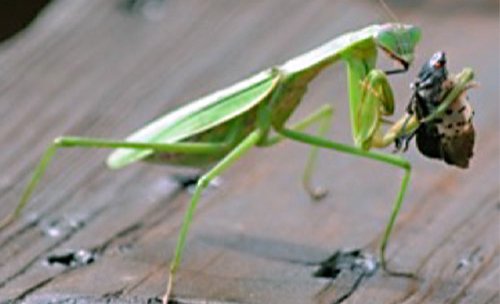
Spotted lanternfly adult being eaten by a praying mantis. Photo: PennState Extension.
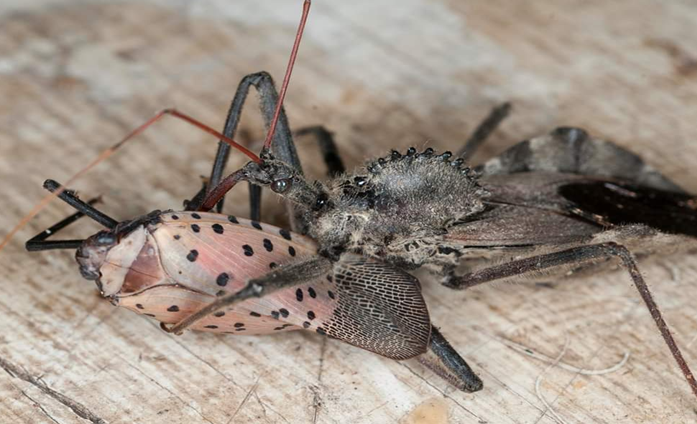
Spotted lanternfly being consumed by a wheelbug.
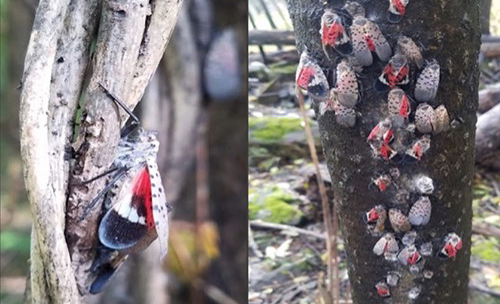
Spotted lanternfly adults in Pennsylvania, infected by fungi closely related to Entomophaga sp. Photo: PennState Extension.
Cultural Control
Removing Preferred Host Plants
If tree-of-heaven is found on the property, we recommend its removal, if possible and practical. When removing tree-of-heaven, you should use an herbicide (see Tree of Heaven for more information). If there are other tree species on the property that are not highly valued by the homeowner and have high populations of SLF, they could also be removed. Removal of preferred hosts, including wild grape and oriental bittersweet, might help reduce populations of SLF. Trees that overhang outdoor living spaces such as patios or pools can be pruned to reduce dropdown of SLF and honeydew/sooty mold accumulation. Otherwise, consider treating these trees with an insecticide to reduce the nuisance in these areas.
Scraping Egg Masses
Scraping SLF egg masses and placing them permanently in an alcohol solution (e.g., rubbing alcohol, hand sanitizer) is another approach to reduce SLF damage. It is important to consider that SLF egg masses are laid on many surfaces, including rocks, trees, fence posts, and outdoor furniture. Additionally, because egg masses can be found at all heights on a tree, safely reaching all of them is not practical.
Chemical Control
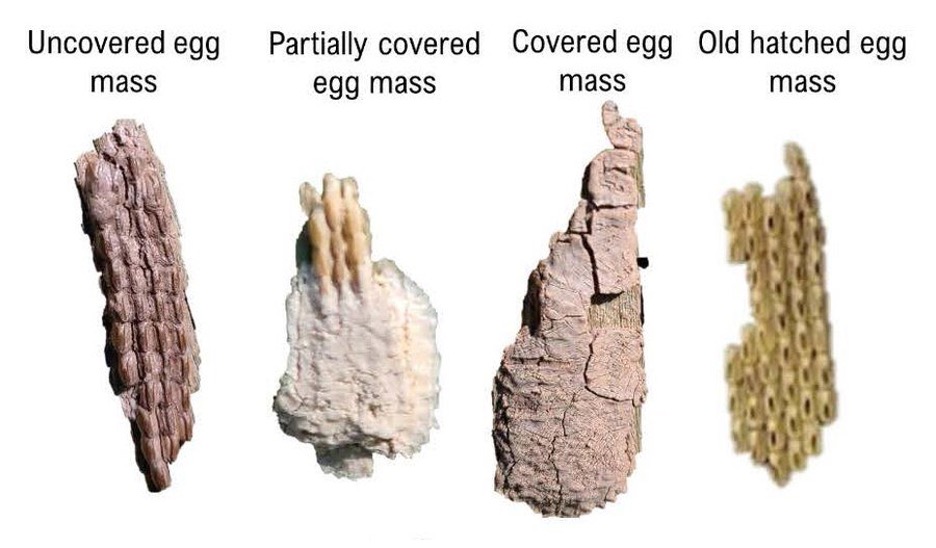 Variations in spotted lanternfly egg masses including color (yellow, gray, brown) and covering. Photo Heather Leach.
Variations in spotted lanternfly egg masses including color (yellow, gray, brown) and covering. Photo Heather Leach.
Ovicides
Based on studies done in 2018 and 2019, our results suggest some insecticides have ovicidal action against SLF eggs. All studies were done on intact egg masses (with covering) between February and April. Although many synthetic insecticides were tested against SLF eggs, the most effective products tested were paraffinic and/or mineral oils such as JMS Stylet oil, Damoil and Lesco Horticultural oil, commonly used in fruit systems as insecticides to control soft bodied insects. Many of these oils are also available to residents at local garden centers. When oils were applied at a solution of at least 3 percent, they were effective in killing up to 75 percent of treated eggs. One of the most important parts to getting effective control is to make sure you have good coverage and apply the oil solution directly to the egg masses. The only plant-based oil, soybean oil, had similar control of SLF egg masses when applied at a 50% concentration. Oils, when applied at the correct time and with good coverage, can offer some control of egg masses and have very little non-target effects. The use of oils provides not only a safe, environmentally friendly option but also provides control to some egg masses that are not accessible for physical removal or smashing. However, for egg masses that are within a reachable area, smashing or scraping the egg masses will provide greater efficacy than the ovicides currently available.
Contact Insecticides
Many commonly available insecticides that kill insects on contact are effective against SLF. Efficacy, residual activity, and toxicity vary between products. We recommend trying the least toxic options first. Toxicity to mammals can be determined from the LD50 values found on the Safety Data Sheet (SDS) for each product, and toxicity to birds, fish, and bees can be found in the table below. If systemic insecticides are not used, frequent use of contact insecticides may be needed to control SLF for the entire season. Always apply insecticides after bloom is finished to help protect natural enemies and pollinators.
*Some trees are sensitive to horticultural spray oil.
Note: This is a guide for when to use management tactics to manage SLF. Read each label carefully and apply according to the label directions. These are our current best recommendations for management tactic timing, but not all combinations of active ingredient, timing, application methods, and tree species have been tested.
Systemic Insecticides
We recommend the use of systemic insecticides for adult SLF control only in high-population areas and high-value trees. Research trials are ongoing to evaluate the best application method, active ingredients, how much insecticide is needed to kill SLF, and how long the insecticide application will last. Based on current data, most systemic applications will last at least two months. Obtaining additional months of control is possible but highly variable depending on many factors (application method, active ingredient, weather, tree species and size, etc.). Proper timing of the application also seems to be very important for effectiveness.
Always read the label and apply the pesticide according to directions. Certain products and/or applications may have restrictions on the cumulative amount of pesticide applied per designated timeframe or acreage. It is illegal to exceed limits of product use that are specifically stipulated by the label. This is true regardless of lack of adequate target pest control (SLF) due to the variable conditions as noted above. Always apply insecticides only after bloom is finished to help protect natural enemies and pollinators.
Three application methods are used to get systemic insecticides to be taken up by the plant: injection, trunk sprays, and soil drenches.
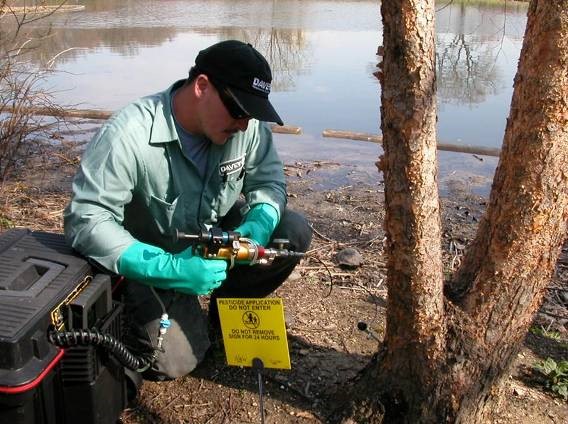 Trunk Injection - photo credit: Phil Lewis, USDA
Trunk Injection - photo credit: Phil Lewis, USDA
Trunk Injection
Based on current information, injection with dinotefuran has been successful at killing SLF in a variety of tree species, including tree-of-heaven, silver maple, and red maple. Death of SLF has been observed in less than 24 hours after injecting a tree. Injections with imidacloprid have also been evaluated with good success.
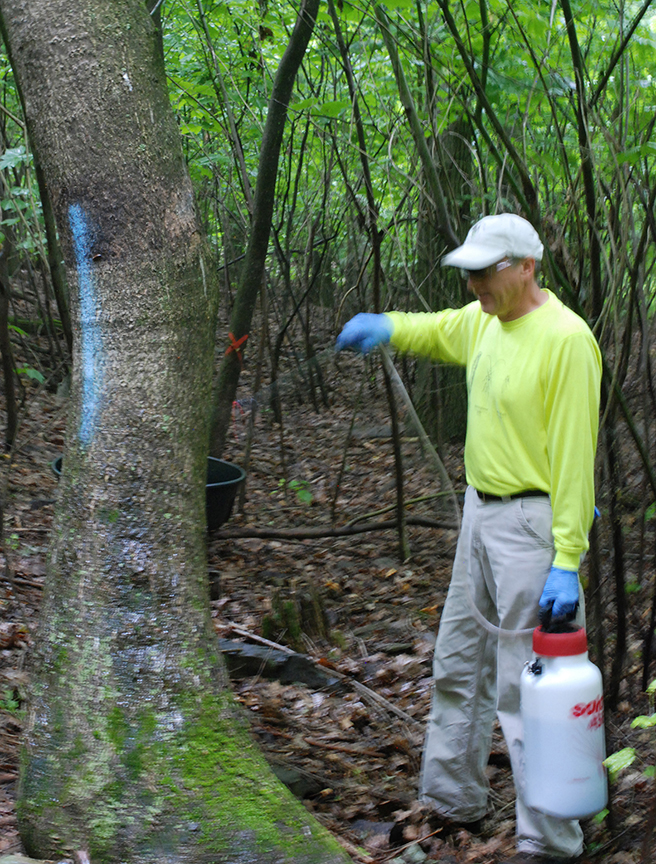 Trunk Spray - photo credit: Phil Lewis, USDA
Trunk Spray - photo credit: Phil Lewis, USDA
Trunk Spray
Trunk sprays with dinotefuran have also been successful. This treatment program is currently being used by USDA APHIS and the Pennsylvania, New Jersey, and Virginia Departments of Agriculture. Observed death of SLF may take longer than with injected applications but is still likely to occur within a few days of treatment. If the label requires a bark penetrant, be sure this is included in your application. Trunk spray applications of imidacloprid have had variable results and more research is needed.
Soil Drench
Little data on soil drench applications of insecticides to control SLF is available to date. The insecticide needs time to be taken up by the tree roots, and this is often the method with the greatest time delay until it begins to kill SLF. Postbloom spring applications of imidacloprid soil drenches are recommended, whereas dinotefuran should be applied midsummer until September to target adult SLF. Soil drench application is a commonly used method, especially for formulations widely available to home gardeners. Read the label carefully and follow the directions to achieve best results.
Systemic Products
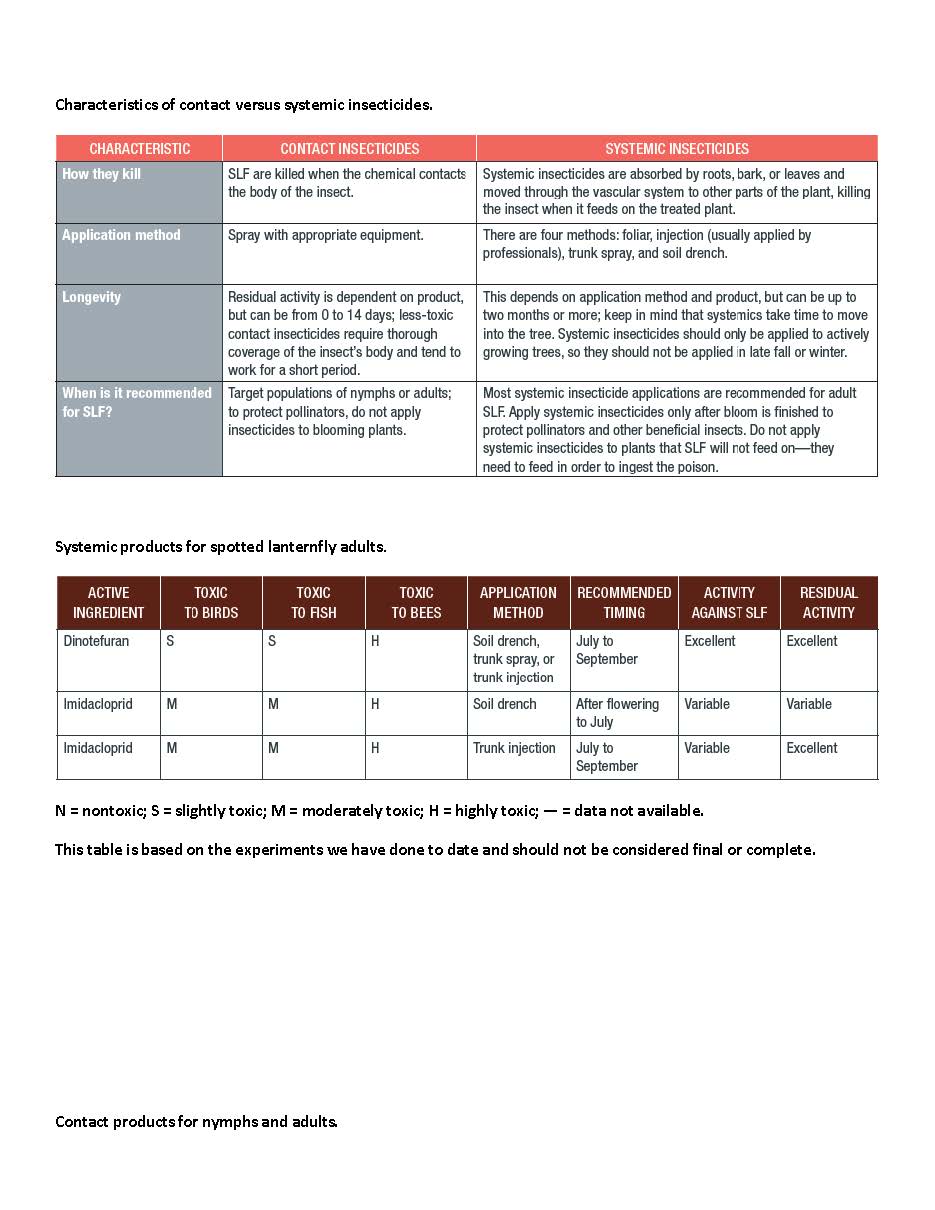
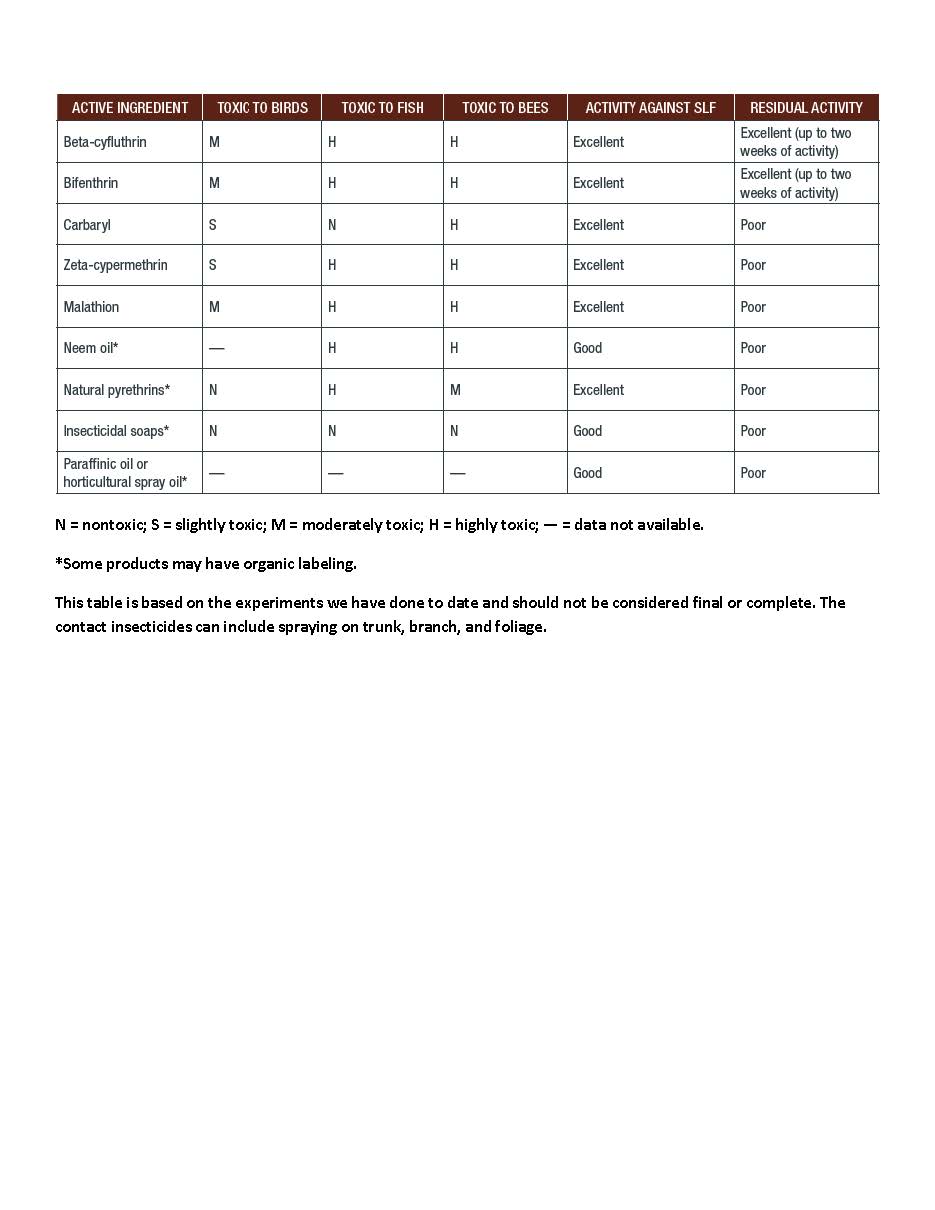
Potential Non-target Effects of Insecticides
Water Contamination
Every precaution should be taken to protect surface water and groundwater from pesticide contamination. Trunk injections pose the smallest risk to contaminating water because the insecticide goes directly into the tree. Soil drench applications should only occur directly adjacent to the trunk of the tree, as directed on the label. Soil drenches should not be applied to sandy soils or where the water table is shallow. Both dinotefuran and imidacloprid can persist in groundwater for extended periods. When exposed to sun, both of these compounds break down readily. To protect surface water, systemic insecticides should not be applied near open water sources (ponds, lakes, streams).
Pollinators & Other Insects
Many of the trees on which SLF have been observed feeding in high densities are also pollinated by bees (e.g., maples and oaks). It is possible that trees treated with systemic insecticides could have insecticide residue in the flowers and nectar the following spring. Neonicotinoid insecticides, in particular, have been associated with bee health decline. Additionally, there are many native insects that utilize these trees at the same time as SLF (e.g., caterpillars, beetles, lady beetles, lace-wings, parasitoid wasps) and could be affected by the treatment. Pyrethroids can also be damaging to natural enemy populations and could cause populations of secondary pests, such as mites and scale, to flare up. Generally, systemic insecticides are considered to have a reduced impact on natural enemies compared to broad-spectrum foliar-applied insecticides. We are currently conducting research to determine the effect of SLF treatments on pollinators and other non-targets.
Tree of Heaven
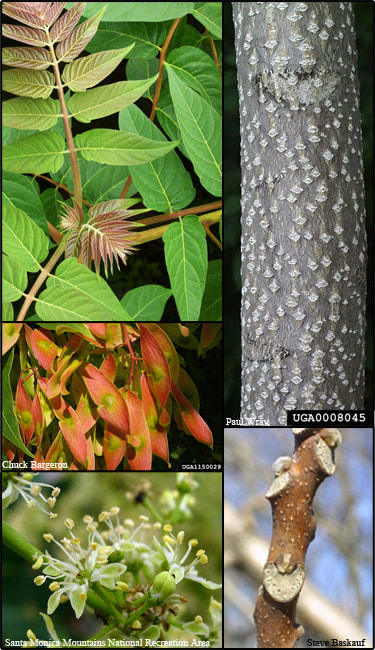 Tree of Heaven (Ailanthus altissima), is an invasive and rapidly growing deciduous tree.
Tree of Heaven (Ailanthus altissima), is an invasive and rapidly growing deciduous tree.
Tree of Heaven (Ailanthus altissima), is an invasive and rapidly growing deciduous tree, now common to urban, agricultural, and forested areas. Spotted lanternfly is particularly attracted to tree-of-heaven. Learn how to identify and manage the tree and why it's important to the fight against spotted lanternfly.
Traps
DIY Spotted Lanternfly Circle Trap
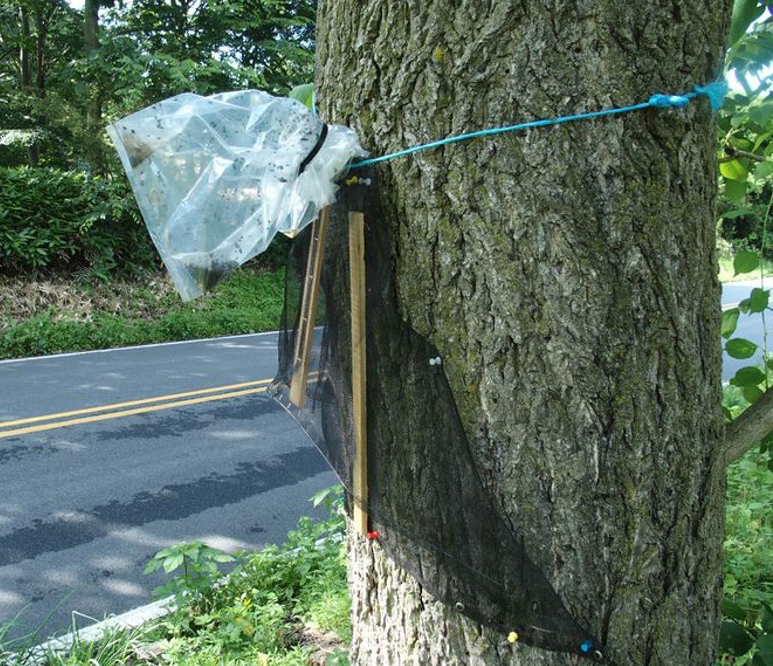
Trap - photo/Emelie Swackhamer
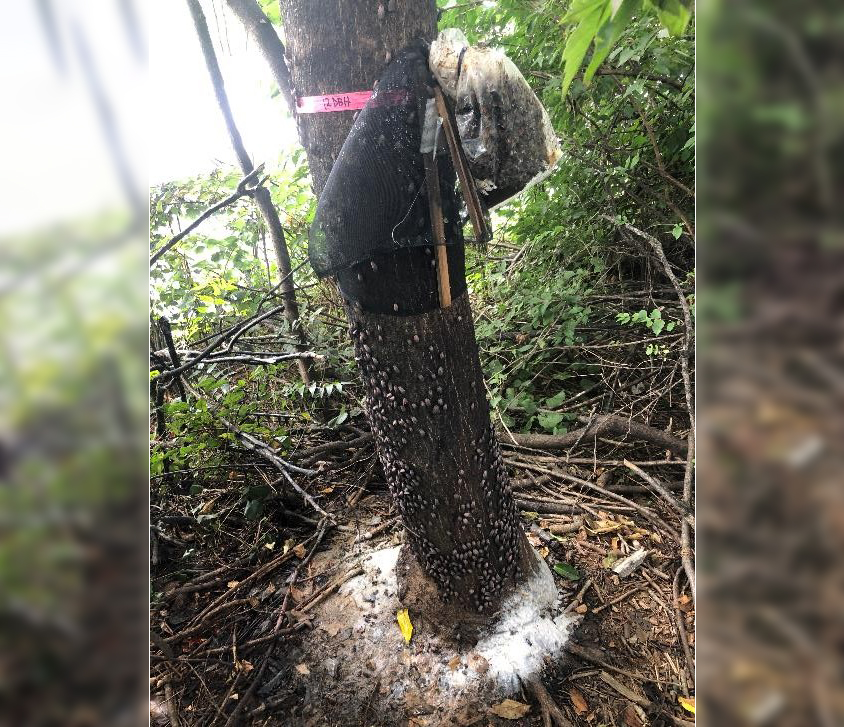
Contact Trap with Gooey stuff - photo credit: Phil Lewis, USDA
NJDA Spotted Lanternfly Survey Staff
If a staff member from the NJDA requests to survey an outdoor area, they will be wearing easily identifiable attire as shown below. Staff members will always carry State or Federal identification on them. The survey staff will only request to survey outdoor areas where the Spotted Lanternfly have been reported.
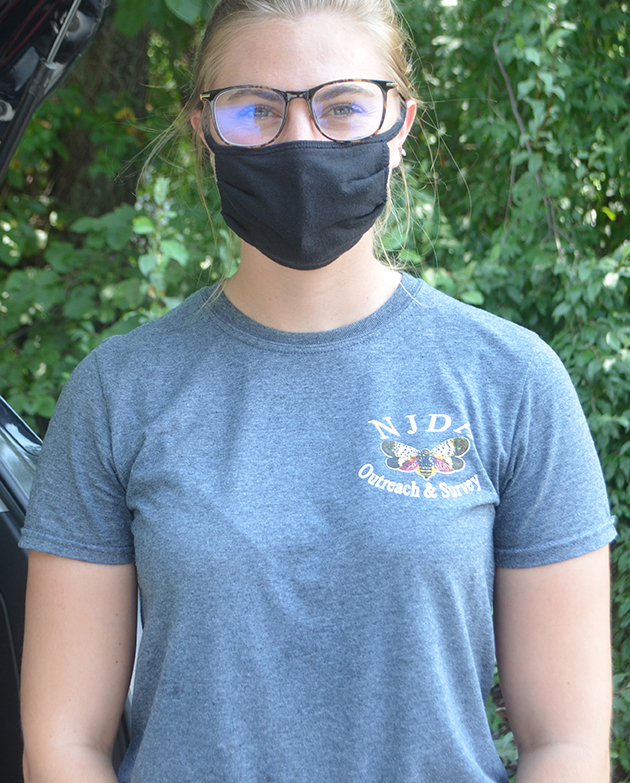
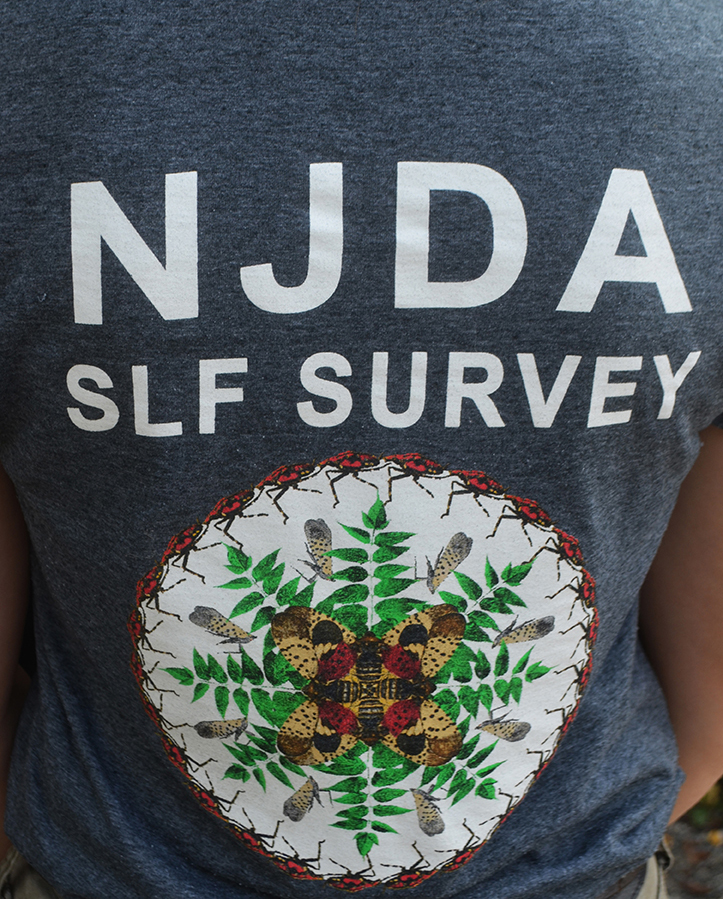
 Official Site of The State of New Jersey
Official Site of The State of New Jersey
